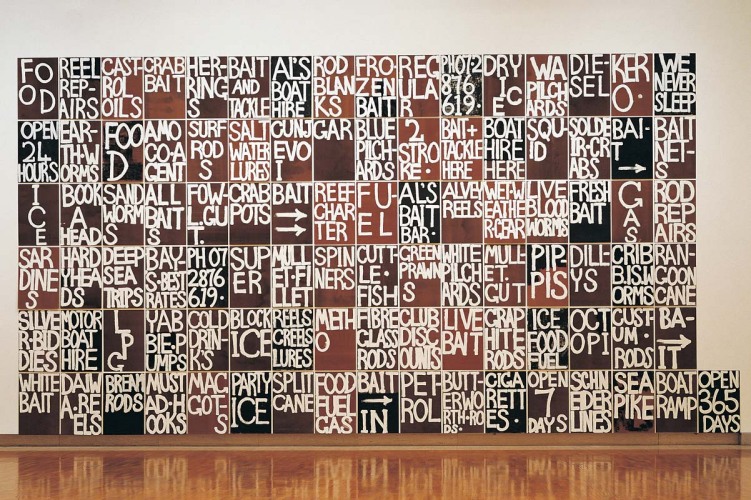We acknowledge the Traditional Owners of the land on which the Queensland Art Gallery | Gallery of Modern Art stands and recognise the creative contribution First Australians make to the art and culture of this country.

Robert MacPherson / Australia 1937–2021 / Mayfair: (Swamp rats) Ninety-seven signs for C.P., J.P., B.W., G.W. & R.W. (installation view) 1994–95 / Acrylic on masonite / 97 panels: 92 x 61cm (each) / Purchased 1998 with a special allocation from the Queensland Government. Celebrating the Queensland Art Gallery’s Centenary 1895–1995 / Collection: Queensland Art Gallery | Gallery of Modern Art / © Robert MacPherson
Robert MacPhersonMAYFAIR: (SWAMP RATS) NINETY-SEVEN SIGNS FOR C.P., J.P., B.W., G.W. & R.W. 1994–1995
Not Currently on Display
Mayfair: (Swamp rats) Ninety-seven signs for C.P., J.P., B.W., G.W. & R.W. consists of 75 standard-sized masonite panels painted in the manner of the homemade roadside advertisements commonly found dotted along Australian highways. Arranged together as a grid on the gallery wall, these banal signs are elevated to form a monumental painting.
This work is part of MacPherson’s ‘Mayfair’ series that celebrates aspects of ordinary life. It is dedicated to the everyday lives of a group of fishermen, or ‘swamp rats’, who inhabit the marshy zone near the mouth of the Brisbane River, and whose initials form part of the work’s title. Although the work presents an overwhelming assemblage of painted words, its clear meaning is fractured.
The viewer may interpret the work visually as an abstract image, or see the stretched, condensed and broken words as a form of poetry. MacPherson has long encouraged this association, believing that the work can be understood in both ways.
Brisbane-born Robert MacPherson is one of Australia’s leading conceptual artists. A key aspect of his art is the way in which the identity of things is created by how we classify them.
His ‘serial’ works often combine local knowledge and humour with a highly informed commentary on contemporary art through the use of a sequence of similar or identical objects. The continuity suggested by serial, repeatable units, indicates that the work is a detail within a much wider system, a complex grid of interlocking factors that defines the meaning and identity of things.
MacPherson travelled extensively throughout Europe and the US during the 1970s, and held several solo exhibitions at the Ray Hughes Gallery in Sydney and the Institute of Modern Art in Brisbane during the 1970s and 80s. In 1977 he received a Visual Arts Board Grant from the Australia Council for a studio in New York , and in 1992 was awarded an honorary doctorate from Griffith University. Five years later, he received the Australia Council’s Artist Emeritus award.
Discussion Questions
1. This work can be seen as an abstract painting or as a type of visual poem. How is this different to other poems you have read?
2. What features of MacPherson’s work are consistent with post-modern art making practice?
Classroom Activities
1. Explore the way signage uses a visual form of communication to impart information. Gather examples of a range of different signs from newspapers, magazines and the internet. Using water-based paints, create your own signs to reflect a significant or humorous meaning. Working as a class, experiment and arrange the signs to create a visually compelling work.
2. Make a collection of images (drawings or photographs) of letterboxes or other common objects that appear in your neighbourhood. Consider various ways of arranging these images to construct an artwork. What concepts/themes does your artwork address?